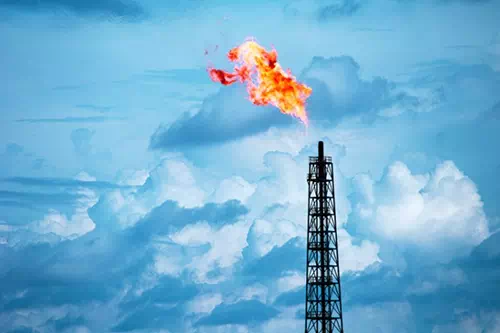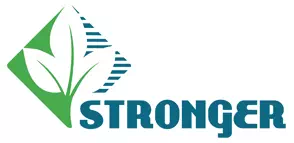 |
Gathering Operations-Lines/Dehydration
Natural gas streams moving along within the gathering pipeline are frequently subjected to an extraction process to remove water and other impurities prior to reaching the gas plant. For example, associated with gathering lines, are additional processing operations to further dehydrate the natural gas. This can be achieved with solid-desiccant dehydration, which consists of two or more adsorption towers, which are filled with a solid desiccant. These types of dehydration systems are usually located on a pipeline downstream of a compressor station because they are best suited for large volumes of gas under very high pressure. Typical desiccants include activated alumina or a granular silica gel material. Wet natural gas is passed through these towers, from top to bottom. As the wet gas passes around the particles of desiccant material, water is retained on the surface of these desiccant particles. Passing through the entire desiccant bed, almost all of the water is adsorbed onto the desiccant material, leaving the dry gas to exit the bottom of the tower. To 'regenerate' the desiccant, a high-temperature heater is used to heat gas to a very high temperature. Passing this heated gas through a saturated desiccant bed vaporizes the water in the desiccant tower, leaving it dry and allowing for further natural gas dehydration. Possible federal regulations affecting dehydration include:
-
Clean Air Act (CAA)
- 40 CFR Part 60 Subpart A. General provisions, including control device and work practice requirements for flares and compliance with standards and maintenance requirements (maintain air pollution control equipment in a manner consistent with good air pollution control practice for minimizing emissions).
- 40 CFR Part 63 Subpart A. General provisions, General provisions and compliance with standards and maintenance requirements (maintain air pollution control equipment in a manner consistent with good air pollution control practice for minimizing emissions).
-
40 CFR Part 60 Subpart OOOO and Subpart OOOOa. Standards for Performance for Crude Oil and Natural Gas.
- 40 CFR 63 Subpart HH. National Emission Standards for Hazardous Air Pollutants from Oil and Natural Gas Production Facilities.
- 40 CFR 98 Subpart W. Petroleum and Natural Gas Greenhouse Gas (GHG) Reporting Rule.
-
40 CFR 68 and CAA 112(r)(1). Chemical accident prevention provisions and the Risk Management Program.
- General Duty Clause (Section 112(r)). Directs owners and operators of stationary sources to identify hazards that may result from accidental releases, to design and maintain a safe facility, and to minimize the consequences of releases when they occur.
- Standards of Performance for Stationary Compression Ignition Internal Combustion Engines (NSPS Subpart IIII). Applicable to certain engines used in generators, compressors, pumps and similar equipment.
- Standards of Performance for Stationary Spark Ignition Internal Combustion Engines (NESHAP Subpart JJJJ). Applicable to certain engines used in generators, compressors, pumps and similar equipment.
- 40 CFR 63 Subpart ZZZZ. National Emission Standards for Hazardous Air Pollutants for. Stationary Reciprocating Internal Combustion Engines (RICE).
- CERCLA. Reporting of spills if above reportable quantity for waste oils (e.g., F010, K042 through K048).
- Emergency Planning and Community Right-to-Know Act (EPCRA) (Sections 302, 303, 311, and 312). EPCRA requires facilities that use or store hazardous chemicals in certain quantities to report those inventories to state and local emergency planning organizations.
- Resource Conservation and Recovery Act (RCRA) Subtitle C (hazardous waste) and Subtitle D (solid waste). RCRA is the primary law for regulating solid and hazardous wastes.
- Available emergency response authorities to address adverse impacts:
-
Safe Water Drinking Act (SDWA) (Section 1431). Action to address imminent and substantial endangerment caused by contaminants present or likely to enter a public water system or underground source of drinking water.
-
Clean Air Act (CAA) (Section 303). Action to address imminent and substantial endangerment of public health or welfare, or the environment from air emissions or pollution.
- Comprehensive Environmental Response, Compensation, and Liability Act of 1980 (CERCLA) (Section 104) Removal action to address release that may present imminent and substantial endangerment, subject to the "petroleum exclusion."
- Comprehensive Environmental Response, Compensation, and Liability Act of 1980 (CERCLA) (Section 106). Order to address imminent & substantial endangerment, subject to the "petroleum exclusion."
- Clean Water Act (CWA) (Section 504). Action to address imminent & substantial endangerment to health, welfare, or livelihood caused by discharge from "pollution source."
-
CWA/OPA 311 action to address imminent and substantial threat to public health or welfare from discharges of oil or hazardous substances to navigable waters.
- Resource Conservation and Recovery Act (RCRA) (Section 7003). Action to address solid waste handling that may present an imminent & substantial endangerment to health or the environment.
|
|






